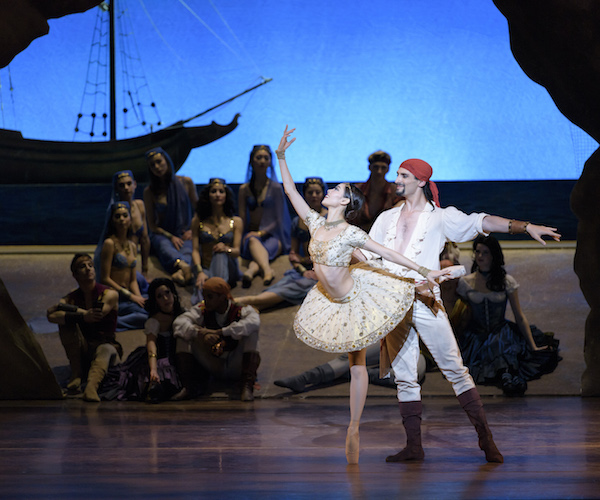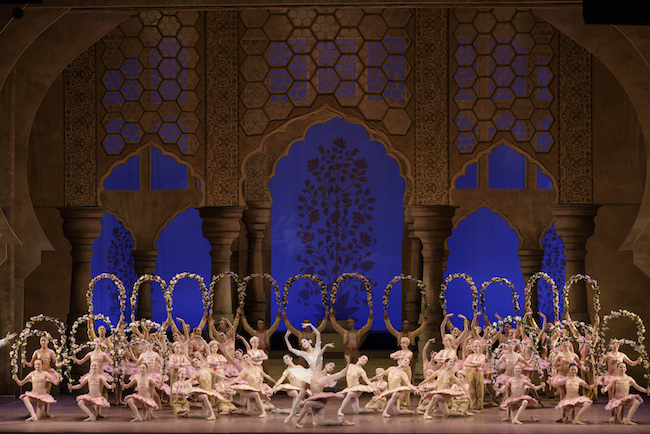Dance Review: Trophy Games at the Boston Ballet
You’re not supposed to look for deep meaning in this often-revised jumbo of a ballet; you can just sit back and enjoy the lavish costumes, sets and dancing.
Le Corsaire, choreography by Ivan Liška after Petipa, by Boston Ballet. Boston Opera House, through November 6.

A scene from Boston Ballet production of Ivan Liška’s “Le Corsaire.” Photo by Liza Voll.
By Marcia B. Siegel
If there’s any theme holding Le Corsaire together, it could be the idea of captivity. Nearly everyone in Boston Ballet’s production of the 19th century ballet is either a prisoner or an abductor, a slaver or a buyer of slaves. Of course, you’re not supposed to look for deep meaning in this often-revised jumbo of a ballet; you can just sit back and enjoy the lavish costumes, sets and dancing. But with our election churning around a not-so-subliminal misogyny and a revitalized feminism, it’s hard not to see Corsaire in this light.
Sorting out the cast of thousands and the overgrown plot, there’s the hero, Conrad, a corsaire, or pirate (played on Saturday afternoon by Paul Craig). He and his accomplices arrive in the marketplace of “Andrinopel,” a fictional locale somewhere in the Middle East that’s populated by townsfolk, urchins, slave girls, and palace guards.
Medora (Maria Baranova) appears and is smitten with Conrad, but she catches the eye of the Pasha (Lasha Kozashvili), who strikes a deal with her calculating guardian, the slave trader Lankedem (John Lam). The Pasha has already purchased another girl, Gulnara (Anaïs Chalendard), and Lankedem gives in reluctantly to the Pasha’s bargain: when Medora is in his hands, Lankedem will get paid. Are you following this?
After that, even the program synopsis gets confusing. There’s a big dance with swords by the corsaires and the slave girls, with several small children on an upstage ramp imitating their moves. By the end of Act I the corsaires have stolen not only Medora and Lankedem and the slave girls, but whatever trinkets they can grab from the marketplace. They all repair to an island in Act II, where they engage in seductions, fights, and role exchanges. Not all of these make sense. For example, the Pasha’s slave Ali (Florimond Lorieux) has mysteriously joined the corsaires and has become Conrad’s buddy, while Conrad’s best friend Birbanto (Roddy Doble) now becomes his enemy and splits up the corsaire troupe. The bandits snatch Medora and run off, but Birbanto returns, to be stabbed by Ali.
It all gets resolved after an intermission. More disguises, dancing harem girls, flirtations, and escapes. The Pasha is duped again, as the corsaires, now mysteriously having rejoined their original leader, Conrad, and returned to Andrinopel, snatch Medora up again and make off for the ship. Gulnara, a funloving golddigger, stays with the harem and the Pasha.
Even if you could follow this narrative, you don’t need to know it. The production is a visual and choreographic feast. Not surprisingly, the main dancing parts have been extracted over the years as stand-alone numbers. But these also get restaged. The Pas de Deux (there are several in Liška’s ballet) was famously done by Rudolf Nureyev as the Slave, with Margot Fonteyn as his partner. Liška stages it as a trio, with Ali, the slave, attending Conrad and Medora. This production includes the “Pas des Odalisques” for three tutu-clad harem girls, and the grandiose Jardin Animé for the whole ensemble of townspeople, harem women, corsaires and assorted lovers and children.
In the big classic ballets, dance numbers are usually passed down through the years from one cast to the next, and altered to suit the circumstances. We can’t know exactly what they looked like when created. The intrepid dance historian and reconstructor Doug Fullington worked with Liška in Munich when he made this Corsaire for the Bavarian State Ballet in 2007. Fullington located Stepanov notation scores from Petipa’s final rethinking of the ballet in 1899—now housed in the Harvard Theater Collection—and reconstructed what he could from that documentation. In a very informative program note, Fullington explains the process of bringing the dances back, not neglecting to mention where compromises were made with Liška and contemporary tastes. I wouldn’t be surprised to learn there was also some Soviet influence.
Ivan Liška, who choreographed and directed it, grew up behind the Iron Curtain in Prague before moving to Germany, where he danced and in Hamburg and Munich, then began choreographing. Liška’s Le Corsaire inherits a pock-marked history. Originally staged by Joesph Mazilier in Paris in 1856, it was redone seven years later in St. Petersburg by Marius Petipa. The score by Adolphe Adam, composer of Giselle, got chopped up by Petipa, who interpolated three or four other composers’ music. Boston Ballet’s program doesn’t tell us whose music is attached to which scenes.

Photo: A scene from Boston Ballet production of Ivan Liška’s “Le Corsaire.” Photo by Liza Voll.
One thing I liked about the dancing was the addition of expressive gestures to indicate who the dancers were. When Medora dances for Conrad on the island, she coyly delays going to bed with him, even though she’s traded her big tutu for a nightgown. At one point she puts on his vest and dances with what she believes are corsairish gestures.
This, and Gulnara’s spunky solos in the first act, are about the only examples of women showing any independence. The harem women are there to be looked at and used in any way their master wishes. Even these two principal women are shoved around and taken by force without a sign of resistance.
Another asset of these big old ballets is how much classical dancing they contain. In the women’s solo variations and the Pas des Odalisques, you get to see the step vocabulary used in more intricate detail than contemporary ballets bother with. Both men and women jump spectacularly. All this in addition to sinuous displays of skin. The slave girls and harem women wear tiny bras and filmy skirts that begin below the navel, and the men frequently go barechested.
The 19th century also specialized in great proliferating displays of ensemble dancing. In the Jardin Animé (Garland Dance) you could see the lineage of Michel Fokine’s cleaned-up modernism. His revolutionary works for the Diaghilev ballet, Firebird, Schéhérazade, and Petrouchka (all choreographed before 1913), melded together groups of characters from different stations in life, making them into one community with the use of unison groups in carefully laid out patterns. Liška/Fullington’s Jardin is a grand display of over 75 dancers entering and forming new designs like an endlessly blooming garden.
Internationally known writer, lecturer, and teacher Marcia B. Siegel covered dance for 16 years at The Boston Phoenix. She is a contributing editor for The Hudson Review. The fourth collection of Siegel’s reviews and essays, Mirrors and Scrims—The Life and Afterlife of Ballet, won the 2010 Selma Jeanne Cohen prize from the American Society for Aesthetics. Her other books include studies of Twyla Tharp, Doris Humphrey, and American choreography. From 1983 to 1996, Siegel was a member of the resident faculty of the Department of Performance Studies, Tisch School of the Arts, New York University.
